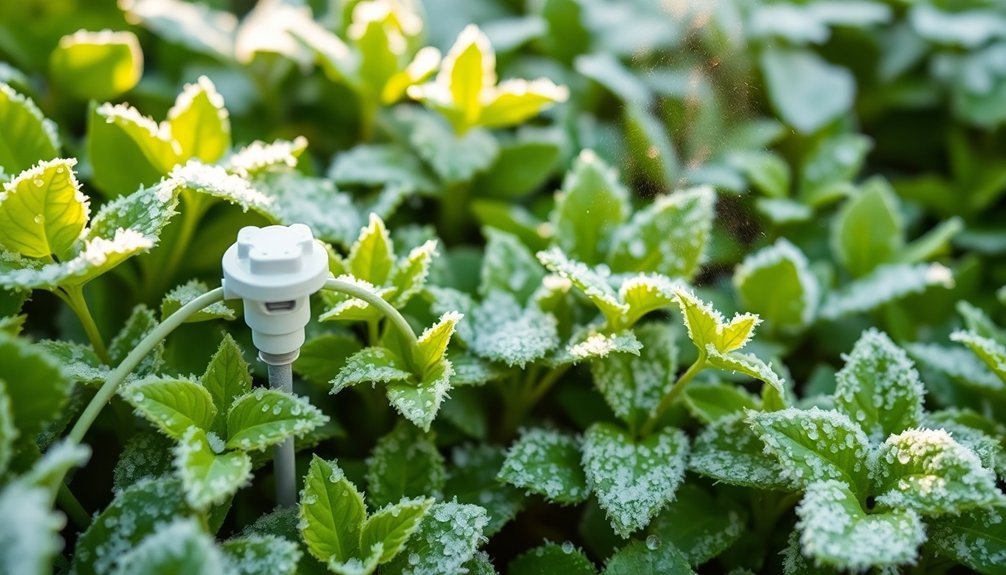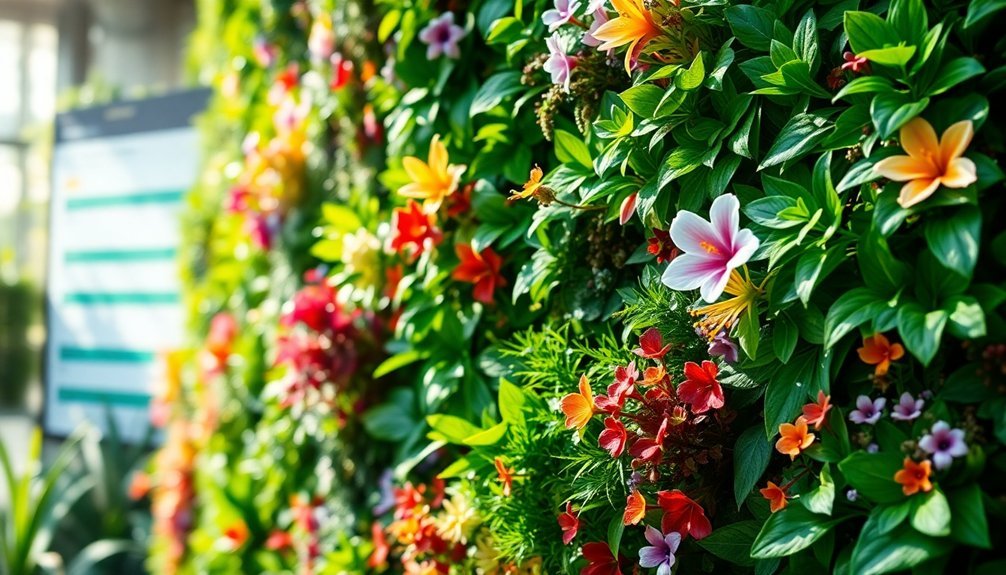To keep your living wall thriving year-round, adjust irrigation seasonally—reduce watering in winter while ensuring proper drainage to prevent root damage. Select diverse plants that offer continuous visual interest, combining evergreens with seasonal bloomers for constant texture and color. Implement a professional maintenance schedule with quarterly evaluations and beneficial insect introductions to enhance biodiversity. These strategic adaptations will transform your living wall into a resilient, flourishing ecosystem regardless of changing weather conditions.
Winter-Proof Your Living Wall With Smart Irrigation Adjustments

As winter approaches, properly managing your living wall's irrigation becomes essential to its survival. Reduce watering frequency to match decreased plant needs during dormancy and lower evaporation rates.
Check that your soil drains well to prevent freezing waterlogging that can damage roots. Well-draining soil becomes critical for preventing root rot during winter months. Inspect your irrigation system thoroughly—look for potential blockages and leaks in pipes and connections.
Consider installing freeze protection modules with temperature sensors that automatically shut off water flow during freezing conditions. For extreme cold areas, add insulation or heating cables to vulnerable pipes.
During thaws, manually check soil moisture before watering. It should remain moist but never waterlogged.
You'll need to temporarily shut off systems during freezes and properly drain pipes to prevent ice damage.
Seasonal Plant Selection for Year-Round Living Wall Vibrancy
Selecting the right plants for each season guarantees your living wall remains vibrant throughout the year. For sunny walls, incorporate Ceratostigma plumbaginoides and Nepeta racemosa 'Walkers Low,' while shaded areas benefit from Hydrangea anomala and various ferns.
Don't overlook edible options—cherry tomatoes and basil thrive in sunny spots, while alpine strawberries and lettuce prefer partial shade.
For year-round consistency, include evergreens like ivy alongside ornamental grasses that provide texture regardless of season.
You'll achieve maximum visual impact by mixing plants with varied foliage colors, such as Heuchera 'Melting Fire.'
During winter, rely on pansies and hellebores for unexpected blooms. Native plants enhance resilience and ecological value, while seasonal bedding plants can be rotated to reflect changing aesthetics throughout the year. Remember to water daily during hot summer months to prevent dehydration and ensure the continued health of your living wall display.
Professional Maintenance Schedule to Maximize Biodiversity Benefits

Beyond plant selection, the biodiversity benefits of your living wall depend heavily on professional maintenance. Implementing a structured schedule guarantees your living wall remains a thriving ecosystem year-round.
Quarterly system evaluations paired with monthly health checks will catch potential issues before they compromise biodiversity support. Early detection of pest infestations through regular inspections helps preserve the ecological balance of your living wall.
To maximize ecological benefits:
- Introduce beneficial insects seasonally as natural pest controllers, reducing the need for harmful chemicals
- Install nesting boxes for bees and birds, creating habitat alongside plantings
- Maintain year-round food sources through strategic pruning and deadheading of flowers
Adjust maintenance intensity with seasons—increase monitoring during spring growth and reduce intervention during dormant periods.
This balanced approach not only protects your investment but enhances your wall's contribution to local biodiversity.
Frequently Asked Questions
How Do Living Walls Impact Indoor Air Quality Throughout Seasons?
Your living walls purify air by absorbing CO2 and filtering VOCs year-round, though they're most effective during heating seasons. They'll trap particulates, provide oxygen, and reduce indoor pollution levels by up to 25% with proper maintenance.
Can I Install a Living Wall in a Rental Property?
You can install a living wall in a rental, but you'll need landlord permission. Consider removable options, mounting systems that won't damage walls, and lightweight plant selections to avoid structural issues or lease violations.
What Are the Energy-Saving Benefits of Exterior Living Walls?
Exterior living walls will cut your energy costs through improved insulation, reducing heat loss by up to 31.4%. You'll need less heating in winter and cooling in summer, as they can lower wall temperatures by 20°C.
How Do Living Walls Affect Building Structural Integrity Long-Term?
Living walls can impact your building's structure over time. You'll need proper waterproofing, regular maintenance, and appropriate weight distribution. Without these, you're risking moisture damage and potential root penetration issues.
What Lighting Systems Work Best for Interior Living Walls?
For interior living walls, you'll get best results with full-spectrum LEDs that provide blue and red wavelengths. They're energy-efficient, customizable for different plants, and won't overheat your installation like other lighting options might.
In Summary
Your living wall doesn't have to struggle through seasonal changes. By adjusting your irrigation system for winter conditions, selecting plants strategically for year-round appeal, and following a professional maintenance schedule, you'll maximize biodiversity while minimizing care issues. Remember, these vertical gardens aren't just decorative—they're living ecosystems that need your attention as seasons shift. With these three approaches, you'll enjoy a thriving living wall regardless of what the calendar says.





Leave a Reply